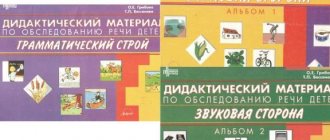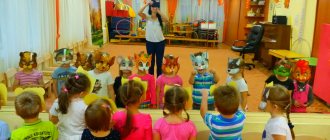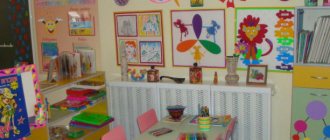The main activities of a preschool teacher
In preschool activities, mental, moral, labor, physical and artistic-aesthetic education are distinguished, but in recent years more and more attention has been paid to environmental and legal education. This is due to the fact that the socio-economic and political situation in the country and throughout the world is rapidly changing, and modern children in these areas are much better developed than their peers of previous years. In addition, the requirements for the development of a full-fledged personality provide for the all-round development of the child, so ignoring the issues of modern times will not bring anything good. Preschool teachers have to use much more knowledge and skills than in previous years, as this is required by the environment and the changed rules for assessing the activities of the teacher and the requirements for them.
The main directions of the teacher’s pedagogical activity include the following sections:
- Self-education.
- Organization of problem-search work for a children's team.
- Expanding the skills and abilities of students through the introduction of new information technologies into their activities.
- Expanding the educational space of pupils.
- The use of special classes to prepare students for school using ICT.
- Expanding the teacher’s own horizons and educational space using the latest information technologies.
The work of preschool teachers and educators is carried out in different directions, but, in essence, is aimed at one most important goal - the formation of a child as an integral creative personality. Therefore, one of the most important tasks of any educator is the harmonious unification of all areas of their activities to achieve their goal.
In the pedagogical literature, there are often 5 main areas of activity of a teacher in a preschool educational institution. These concepts resonate with the job responsibilities of a teacher, but do not copy, but complement them.
You can find many different definitions of the main directions of a teacher’s work, but they all, in essence, boil down to the following brief and succinct formulations:
1. Care.
2. Education.
3. Supervision.
4. Organization of educational work.
5. Conducting educational work.
This can be deciphered as follows:
- Care is caring, patronizing and providing assistance to a pupil. It concerns both training and education, and purely human feelings, as well as the health of the child. The teacher creates a psychologically healthy atmosphere in the children's educational institution, thanks to which the child feels calm, confident, and safe.
- Education is a broad concept that includes both the inculcation of universal human norms and the formation of a free, fully and comprehensively developed personality.
- Supervision involves monitoring not only behavior and academic performance, but also identifying various violations for the purpose of their subsequent correction and correction.
- Organization of educational work is planning and preparation of the entire learning process in a preschool educational institution. It includes numerous stages - from self-education to the production of the necessary visual material.
- Carrying out educational work is the actual learning process, which involves all the knowledge and skills accumulated by the teacher.
Also, the directions of the teacher’s work can be formulated as follows:
- Sports and recreation.
- Spiritual and educational.
- General cultural.
- General intellectual.
- Social.
The presence of several formulations does not introduce different interpretations into the definition of directions of educational activity, but only explains, “deciphers” them.
Types of children's activities in accordance with the Federal State Educational Standard for Education
The Federal State Educational Standard puts at the forefront an individual approach to the child and play, where the intrinsic value of preschool childhood is preserved and where the very nature of the preschooler is preserved. The leading types of children's activities will be: gaming, communicative, motor, cognitive-research, productive, etc.
It should be noted that educational activities are carried out throughout the entire time the child is in the preschool organization. This:
Joint (partnership) activities of the teacher with children:
Educational activities in special moments;
Organized educational activities;
Independent activity of children.
Educational activities are carried out in various types of activities and cover structural units representing certain areas of development and education of children (educational areas).
The main activities of children in preschool educational institutions:
1. Play activity is a form of child activity aimed not at the result, but at the process of action
and
methods of implementation
and characterized by the child’s acceptance
of a conditional
position (as opposed to his real life one).
There are a huge number of classifications of children's games. Traditional classification of children's games:
CREATIVE GAMES: Role-playing games, Directing games, Dramatization games, Theatrical games, Games with building materials, Fantasy games, Sketch games.
GAMES with RULES: Didactic, Mobile.
Story-based role-playing games
The plot of the game is the sphere of reality that is reproduced by children. Depending on this, role-playing games are divided into
:
n Games based on everyday stories;
n Games on industrial and social topics;
n Games on heroic and patriotic themes;
n Games on themes of literary works, films, television and radio programs.
The structure of a role-playing game includes the following components:
n roles played by children during the game;
n play actions with the help of which children implement roles;
n game use of objects (real ones are replaced by game ones).
Relationships between children are expressed in remarks, remarks, and the course of the game is regulated.
Directing games are games in which a child makes dolls speak and perform various actions, acting both for themselves and for the doll. During these games, the child acts as a director, designing actions, coming up with what his toys will do, how the plot of events will develop, and what its ending will be. It is the child himself who plays the role of each toy, comes up with names, chooses the main characters, good and bad characters, and also sets the main rules of the game.
Conditions for the development of director's games:
n Creating an individual space for the child, providing space and allocating time for play.
n Selection of play material (toys, substitute items, various items of clothing) for the child’s director’s play.
n Creating models (a house for a Barbie doll, a model of a knight’s castle or outer space).
Theatrical play is an effective means of socializing a preschooler. It involves emotional development: children become familiar with the feelings and moods of the characters, and master ways of expressing them externally.
Types of theatrical games:
1. Tabletop theatrical games: tabletop toy theater, tabletop drawing theater.
2. Stand theatrical games:
stand-book; flannelograph; shadow theater.
3. Dramatization games including:
finger theater; bibabo theater (glove); puppet show; dramatization game with hats on the head; improvisation.
Playing with building materials is especially close to work activity . They instill in children qualities that directly prepare them for work. They develop children's sensory abilities and reinforce sensory standards.
GAMES WITH RULES
Didactic game
The main goal of any didactic game is educational . The didactic game is specially created by adults
for educational purposes, and then learning proceeds on the basis of a gaming and didactic task. In didactic play, the child not only gains new knowledge, but also generalizes and consolidates it.
By content: Mathematical, Speech, Environmental
Based on didactic material: Games with objects, Board-printed, Verbal: games - assignments, games - conversations, games - travel, games - assumptions, games - riddles.
Outdoor play is one of the means of comprehensive education of preschool children. Active play activities and the positive emotions it evokes enhance all processes in the body, improve the functioning of all organs and systems. Unexpected situations that arise in the game teach children to use acquired motor skills.
2. Cognitive - research activity - a form of child activity aimed at knowledge
properties and connections of objects and phenomena,
mastering
ways of knowing, contributing to the formation of a holistic picture of the world.
Types: Experimentation, research; Modeling: substitution, compilation of models, -activities using models; by the nature of the models (objective, symbolic, mental)
3. Communicative activity is a form of child activity aimed at interacting with another person as a subject, a potential communication partner, involving coordination and joining efforts in order to establish relationships
and
achieving a common result
.
This is constructive communication and interaction with adults and peers;
Oral speech as the main means of communication. 4. MOTOR ACTIVITY - a form of activity of a child that allows him to solve motor problems by implementing a motor function.
Kinds:
— Gymnastics: basic movements (running, walking, jumping, climbing, balance); drill exercises; dance exercises; with elements of sports games.
— Games: active; with elements of sports.
— The simplest tourism.
— Scooter riding, sledding, cycling, skiing.
5. Self-care and elements of household labor - a form of child activity that requires effort to satisfy physiological and moral needs; bringing a concrete result that can be seen/touched/felt.
Types of child labor: Self-service, Household labor, Labor in nature, Manual labor.
The difference between the work of preschoolers:
n A preschooler cannot produce socially significant material assets
, but
the results of some labor processes performed by a child turn out to be useful not only for the child, but also for other people.
n The work of a preschooler is closely related to play (imitation of the work actions of adults).
n In the process of work, children acquire labor skills and abilities, but these are not professional skills , but skills that help the child become independent from adults, independent
.
n The work of preschool children does not have constant material reward.
n The child’s work is situational and optional ; is based on the principle of voluntary participation of the child and excludes coercion.
6. Visual activity is a form of child activity, as a result of which a material or ideal product is created.
Types: Drawing, Modeling, Applique.
7. Constructive activity is a form of child activity that develops spatial thinking, forms the ability to foresee future results, provides an opportunity for the development of creativity, and enriches speech.





